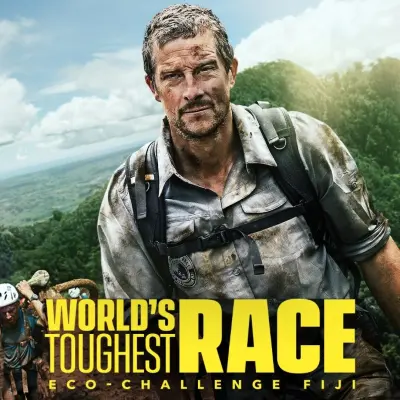Eco-Challenge is better than ever with Amazon reboot World's Toughest Race: Eco-Challenge Fiji
-

World's Toughest Race: Eco-Challenge Fiji feels different because the 66 teams competing on the Bear Grylls-hosted reality show aren't really there for the $100,000 prize. "You need to keep that last part in mind, because even with a 10-episode season, it's hard for (Mark) Burnett and his team to really capture Eco-Challenge as a win-or-lose event," says Daniel Fienberg. "The first episode features one solid bit of back-and-forth jostling between a team of prohibitive favorites from New Zealand and a group of fast-starting Americans determined to make an early statement. From there, though, positions barely change, and even when one team or another gains or loses ground, it's rarely presented as some sort of thrilling endeavor in and of itself. The teams are really competing with their own limitations, as individual racers and as a unit. Within a day or two of racing — the winners complete the course in under six days, but teams have 11-plus days to finish — the gaps between leaders, the middle tier groups and teams struggling to make it to several pre-announced, timed cutoff points can be hours and then days. And that — plus a natural affinity for teams that speak English and thus can give quotable soundbites — means that out of 66 teams at the starting gate, there are at least 30 that don't receive even a second of screen time and at least another dozen that only become relevant when something scary or bad happens to jeopardize their participation."
ALSO:
- World’s Toughest Race is more about the indomitable human spirit, which is great in a Nike commercial but falls flat in a 10-episode series: "Right off, the problem is that there are 66 teams, and there’s no way — in 10 hours — that all of their stories can be told," says Dustin Rowles. "In fact, since roughly half the teams don’t speak English, they’re essentially excluded from the edit unless they are involved in a particularly dramatic moment. Moreover, for many of the teams, there’s no compelling hook — in fact, that applies to most of the frontrunners, who mostly keep their heads down and trudge ahead through rivers, mountain bike paths, rocks that need to be climbed and jungles that need to be walked through. It’s an intense and difficult race that doesn’t leave a lot of time for interpersonal drama, which is what the messy benches among us like so much about Survivor and Amazing Race. It also doesn’t work that well as a competition series. Some may remember that terrible opening season of Amazing Race when the first-place team won by a full 24 hours, and we had to watch as editors attempted — in vain — to manufacture some drama out of the finale. Likewise, in Eco-Challenge, the first few teams finished in the eighth episode. There are 10 episodes."
- World's Toughest Race manages to be compelling TV despite an unwieldy 264 contestants: "This is reality TV at incredible scale—the start line has 66 boats with 264 contestants lined up along the shore of a river—and yet it manages to capture and follow individual human stories exceptionally well, producing uplifting and electrifying television along the way," says Andy Dehnart. "All 10 episodes are on Amazon now; I’ve seen the first three so far. From open wounds to projectile vomiting, it’s more graphic than I expected, but also far more engaging than what I expected from such a sprawling, not-quite-competitive race."
- What it's like to be a camera operator filming World’s Toughest Race: "The large-scale production required 200-plus cameras to collect 1,350 hours of footage in 4K and HDR, with the help of drones and tracking devices," reports Ashley Lee, adding: "Camera operators traveled alongside the teams through jungles, rivers, swamps and mountains, withstanding conditions like harsh rains, unrelenting humidity and the threat of hypothermia without complaint. If the competitors you’re following got lost, you got lost right along with them, circling the same area for hours. Sleep was anything but guaranteed."
TOPICS: World’s Toughest Race: Eco-Challenge Fiji, Prime Video, Bear Grylls, Mark Burnett, Reality TV
More Eco-Challenge Fiji on Primetimer:- World’s Toughest Race: Eco-Challenge Fiji won't return for Season 2
- Mark Burnett, who made Donald Trump a reality star on The Apprentice, seems to have lost his touch for creating hit shows
- Bear Grylls' World’s Toughest Race: Eco-Challenge Fiji halted filming for eight hours over "life-threatening" injuries
- Watch Bear Grylls in Amazon's World’s Toughest Race: Eco-Challenge Fiji trailer
